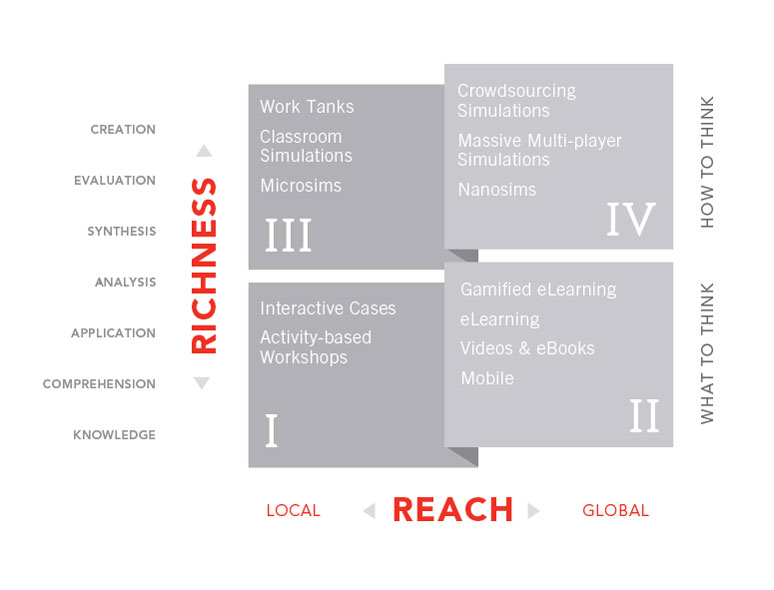You’ve seen this scenario before: the leaders of your organization have decided that a new strategy is in order, one that will take the company to the next level and break through the noise of competitors in the market. Suddenly, you are charged with implementing a new learning program to prepare your organization to execute this bold new strategy. The strategy itself sounds pretty straightforward, exciting in fact. But there’s a problem—your company is big. Multinational big. How are you going to deliver the impact that truly shifts thinking, changes behavior, and readies your team to execute this new strategy?
There are options: you could deliver one, large-scale learning event to all your target learners; or you could coordinate multiple, smaller learning events throughout the course of the year, delivering them in various times and locations. Both scenarios present challenges. Large annual events typically see low retention rates between years, and smaller, disparate sessions tend to lack consistency in delivery and, at times, content. In both cases, information is either lost over time or significant knowledge gaps are unintentionally created—ultimately resulting in a negative impact on your investment. So, where does this leave you?
The key is to grow and nurture a healthy learning ecosystem within your organization. To do so, you must be thoughtful and intentional about the delivery methods you choose. As with any healthy ecosystem, you need the right balance of components that complement each other and contribute back to the system’s whole. You know all too well how daunting it can be to navigate the myriad of platforms, modalities, and solutions out there–so we created the Learning Impact Tool.
A BREAKDOWN OF THE LEARNING IMPACT TOOL
The tool was created to categorize the different types of training solutions in relation to their Richness and their Reach. Richness is defined as the impact of the learning. Along the Richness axis, note the levels of Bloom’s Taxonomy (Knowledge, Comprehension, Application, Analysis, Synthesis, Evaluation, and Creation). The higher on the Richness axis a solution falls, the greater the depth of learning.
The Reach axis describes the ability to deliver a training solution to people wherever they are. The further to the right a solution falls, toward a more global audience, the greater your ability to reach those participants, anytime, anywhere.
While not every training and learning opportunity is captured within the model, below are some of the most common solutions you’ll find available:
QUADRANT I
Within the lower left quadrant of the tool are learning solutions with relatively low levels of richness (focused almost exclusively on information that learners need to know, or foundational knowledge for their role) and limited reach. For example, workshops, even those that incorporate role-plays or activities, primarily deliver basal forms of information and typically only to a set amount of participants who are co-located within a certain location.
QUADRANT II
The lower right corner includes solutions that build a foundation of knowledge through online media—thereby reaching a larger number of learners. E-learning and various social media/Web 2.0/3.0 options make up this quadrant.
These what-to-think quadrants (Quadrant I and Quadrant II) focus on providing employees with knowledge and comprehension-level material, information from which learners must recall specific data, or learn facts, processes, and procedures. Within the first two quadrants can exist powerful tools for delivering foundational information both in local and global settings. However, if paradigm shifts are needed within your organization, they may not offer ideal choices as the primary solution for a learning program. The impact of these programs is often measured by collecting “smile sheets” or completing “seat time.” The number of people in attendance is a primary measure of success for this type of learning—there is plenty of content, but actual behavioral impact is minimal.
Shifting from what-to-think solutions to HOW-TO-THINK solutions, quadrants III and IV focus on higher cognitive skills, such as Analysis, Synthesis, Evaluation, and Creation. As Bloom wisely pointed out, the higher-order thinking skills are personally and organizationally more valuable in the long term, because they can be applied in a variety of situations and they prepare the learner for unexpected variations.
QUADRANT III
The upper left corner represents learning solutions with relatively high levels of Richness (experiences that challenge participants to learn how to think) but limited Reach, such as classroom-based simulations or Work Tanks. A Work Tank combines learning with the actual production of a needed work product for the organization. For example, within a strategic alignment Work Tank, participants develop actual strategies and vet them by running various scenarios across different market conditions. Another example would be a microsim—generally a shorter simulation of less than an hour, that focuses on only a few skills. It is often included in classroom activities or embedded within E-learning modules to increase Richness and provide skill practice.
QUADRANT IV
This area represents solutions that provide high levels of both Richness and Reach through online technologies, such as massive, multiple-player simulations. Quadrant IV–type solutions are targeted at global organizations requiring deep learning and a global audience. These solutions, such as simulations, incorporate the tools necessary for teams to collaborate in solving complex problems.
Within each Quadrant are solutions with unique strengths and particular weaknesses that may help or hinder your objectives for a learning program. It’s important to deliberately select the appropriate learning method or modality and deploy it at the proper time aligned with your learners’ needs. Ask yourself: Who are your learners? Are they high potentials? Are they VPs or perhaps C-level executives? Then consider the learning modality they require and the impact you are looking to make—how well are your current learning programs and solutions working? How well are they supporting each other? There isn’t one, catch-all solution perfect for every scenario nor is there one, catch-all combination of solutions because every organization is different. Examine your company’s current state and seek out the solution or set of solutions that can create a flourishing learning ecosystem that will permeate throughout the rest of your organization.
KEVIN HIMMEL
Managing Director & COO

